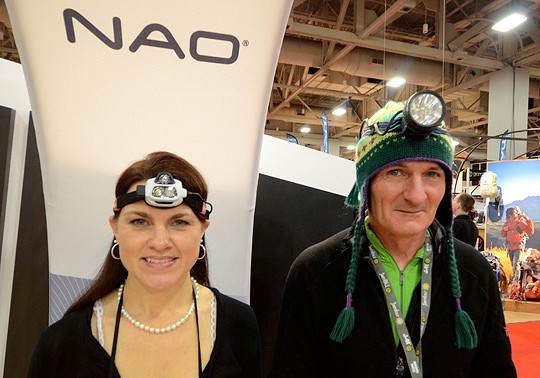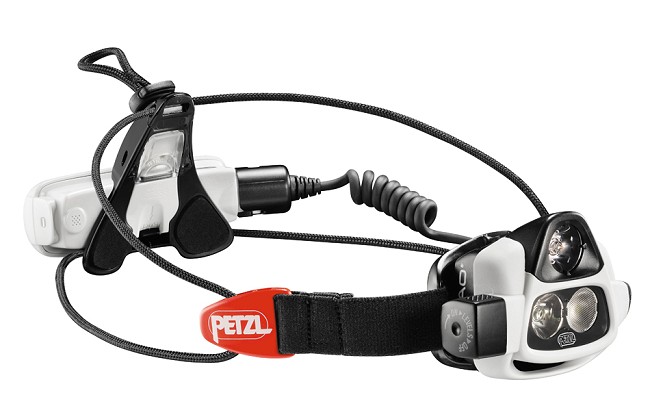
The head torch; a lamp and a battery case attached to headband, was invented by Petzl in 1972. There probably isn't an outdoor enthusiast who doesn't own one or two head torches and I bet quite a few of us still own the original Petzl ZOOM introduced in 1981. Remember those? A large cylindrical head torch with a zoomable incandescent bulb that was angle adjustable and had a reflector, a spare bulb, with a battery pack on the back of your head containing a large non-rechargeable alkaline 4.5 volt battery - the light output was around 25 lumens.

Due to constant innovation, especially by Petzl, better battery power and high-powered LED's, over the last 30 years the performance of head torches has constantly moved forward and feature innovations such as strobe mode, red LED's for night reading, multiple LED's, battery level indicator light, programmable batteries, diffuser screens, buttons for different power levels/settings, removable head straps, retractable head straps, regulated and unregulated power output, and, on and off switch locks.
Whether you are a runner, an ice climber, caver, alpinist, boulderer, an arctic explorer, or just walking down a dark country lane to the pub there is a head torch that will light your way, enable you to do things in the dark and keep you safe. Modern head torches are lightweight, powerful, affordable and essential.
The problem has always been power, or loss of it. For anyone whose batteries have run out on a tricky alpine descent, or even walking off Gimmer Crag in the dark, the consequences can be ankle spraining at the very least.
Spare batteries are essential of course, being able to switch to economy mode and reduce lumens - the amount of light emitted and hence power - when required is now common on most head torches, as is having a switch lock to prevent accidently turning your torch on when in your pack.
Then Petzl introduced CORE, essentially a rechargeable battery (like a camera battery) that you could plug into the mains/or your computer by a USB and recharge, saving not only the expense of buying batteries but also reducing toxic waste. You use your TIKKA2 or ZIPKA2 then come home and recharge, or when on the go plug into your cars 12V outlet. If you so wished, you can plug your headtorch into your computer and using OS Petzl software with a few clicks adjust the battery life of the headlamp or the lighting level according to your needs.
This year, today in fact, Petzl have launched something that they say is the next step in the evolution of head torches.
PETZL NAO HEAD TORCH
The Petzl Nao (pronounced 'now' from the Chinese meaning brain or intellect) features Petzl's REACTIVE LIGHTING technology that uses an integrated light sensor that allows the head torch to instantly and automatically adjust the beam pattern and light output based on conditions; if you are reading a map it switches to proximity lighting - beam is wide and less powerful - if you are descending a ridge it will automatically switch from proximity lighting to distance lighting - beam is more focussed and powerful; depending on where you turn your head.
Similarly when out running, if you are navigating uneven ground it will light up the floor, turn your head up to see in the distance and it will switch to distance vision. So rather than you switching to different light modes the Petzl Nao does it for you allowing you to concentrate on the task at hand and at the same time conserving power.
Average lumen output is a whopping 355 lm (lumen), compare that to the old Zoom's 25 lm output. Burn time or battery life ranges from 4h 40m to 8 hours depending on output. Maximum Beam Distance ranges from 108m at the level 1 setting to 55m at level 2.
NAO rechargeable headlamp with REACTIVE LIGHTING by Petzl
The power source is a rechargeable Lithium-Ion battery strapped in a small case to the back of your head. This like the CORE features USB charging, either using mains, a computer or your car. You can also back that up with a spare Lithium-Ion battery, or with two AAA alkali batteries. The Nao is water resistant and weighs 187g. An Nao belt kit is available so that the Nao battery until can be worn on a belt or pocket to reduce the weight on the head.
The Petzl Nao will be available in the UK in July and retails for £135.
Read the official press release below to find out more.
PETZL NAO HEAD TORCH: OFFICIAL PRESS RELEASE
The Petzl Nao is a new-generation head torch that represents a genuine step forward in hands-free lighting.
The Nao uses Petzl's innovative Reactive Lighting technology, providing light that automatically adapts to your environment. A sensor constantly monitors reflected light from your direction of vision and adapts the head torch output accordingly. This means there is no need to manually adjust brightness when switching between close or distant objects. The dual benefit is automatic optimisation of battery output, giving extended burn times. The Petzl Nao gives you the right light when you need it – automatically.
One of the big problems with today's head torches is the relationship between high-performance LED power consumption and battery capacity. The choices are limited; either unregulated light, giving rapidly diminishing light output, or regulated output where maximum power is only available for relatively short periods.
Petzl's Reactive Lighting technology allows your battery to optimise its output, only providing the power you need for the environment you are operating in. The result is that battery life can last at least three times longer than it would do under constant full power*.
The Petzl Nao features a front headset with twin LEDS and sensor, linked to the rear-mounted battery by the new Zephyr cord-lock headband. The battery is a 2300 mAh lithium-ion unit, rechargeable via an integrated USB plug. There is a belt kit version for the battery, plus a detachable top strap for additional stability when running.
Lighting is controlled via a large rotating on/off switch, which can be locked in the 'off' position. The switch allows the user to choose between Reactive Lighting or Static modes, with high/low output options in each. Static lighting gives a fixed output (non-reactive).
In Reactive Lighting mode the headset uses a single high-output LED in a wide-angled beam. In Static mode the headset uses both the wide-angled beam and a second high-output LED configured for a focused beam. Maximum power output is 355 lumens. Performance profiles can be customised via Petzl's OS 2.0 on your computer.
For 'emergency use', the battery pack will accept 2 x conventional AAA batteries. UK RSP will be £135.00.
*Required output will of course depend on ambient light and the pattern of your usage, ie how much you switch between near/far objects.
Mick Ryan, UKC and UKH Senior Editor, was reporting from the Outdoor Retailer Show in Salt Lake City, Utah. Thank you to Suss Edmundson (headlamp division manager), John Evans and Sonya Griffin (in the photo) of Petzl America, and the Petzl team at Lyon Equipment in the UK.








Comments